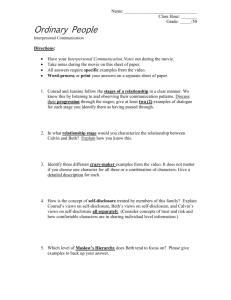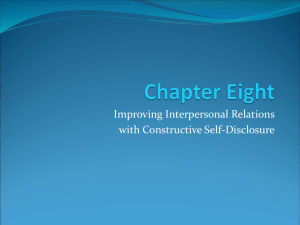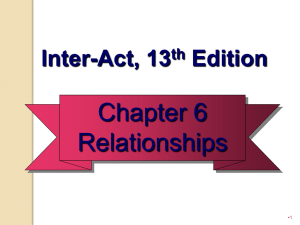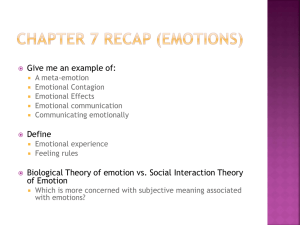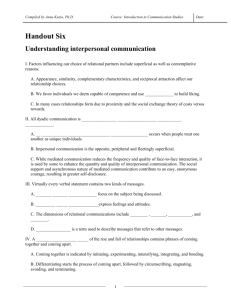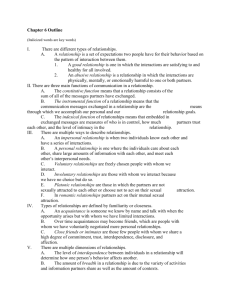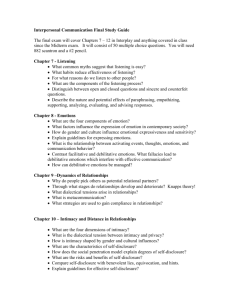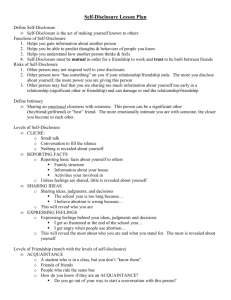application use, online relationship types, self
advertisement
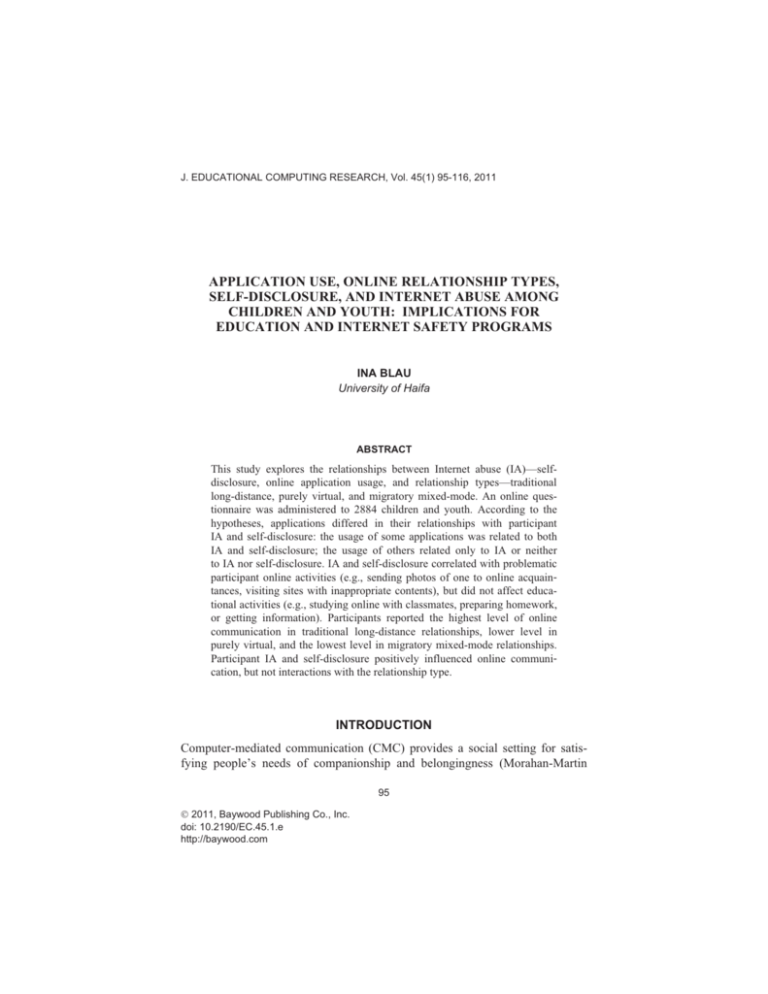
J. EDUCATIONAL COMPUTING RESEARCH, Vol. 45(1) 95-116, 2011 APPLICATION USE, ONLINE RELATIONSHIP TYPES, SELF-DISCLOSURE, AND INTERNET ABUSE AMONG CHILDREN AND YOUTH: IMPLICATIONS FOR EDUCATION AND INTERNET SAFETY PROGRAMS INA BLAU University of Haifa ABSTRACT This study explores the relationships between Internet abuse (IA)—selfdisclosure, online application usage, and relationship types—traditional long-distance, purely virtual, and migratory mixed-mode. An online questionnaire was administered to 2884 children and youth. According to the hypotheses, applications differed in their relationships with participant IA and self-disclosure: the usage of some applications was related to both IA and self-disclosure; the usage of others related only to IA or neither to IA nor self-disclosure. IA and self-disclosure correlated with problematic participant online activities (e.g., sending photos of one to online acquaintances, visiting sites with inappropriate contents), but did not affect educational activities (e.g., studying online with classmates, preparing homework, or getting information). Participants reported the highest level of online communication in traditional long-distance relationships, lower level in purely virtual, and the lowest level in migratory mixed-mode relationships. Participant IA and self-disclosure positively influenced online communication, but not interactions with the relationship type. INTRODUCTION Computer-mediated communication (CMC) provides a social setting for satisfying people’s needs of companionship and belongingness (Morahan-Martin 95 Ó 2011, Baywood Publishing Co., Inc. doi: 10.2190/EC.45.1.e http://baywood.com 96 / BLAU & Schumacher, 2003). Different online tools offer a variety of choices to meet new people, communicate, and develop close relationship with others (Pornsakulvanich, 2005). However, some people experience problems through over-engaging in Internet-related activities. This study explores the relationships between Internet abuse (IA)—self-disclosure, and the usage of different online tools among Israeli children and youth—as well as discusses its implication for education and Internet safety programs. In addition, the study investigates whether the participant IA and self-disclosure differ according to online relationship type—traditional long-distance, purely virtual, and migratory mixed-mode. The next section defines IA and discuses the difference between IA and Internet addiction. Following that, self-disclosure in online communication is compared to self-disclosure in offline environment. The introduction section concludes by discussing three types of online inter-personal relationships: traditional longdistance, purely virtual, and migratory mixed-mode. Internet Abuse There is no standard term for describing Internet-related problems; a number of terms have been used, including Internet addiction, Internet dependency, Internet abuse, compulsive Internet use, pathological Internet use, and problematic Internet use (see Morahan-Martin, 2008). Goldberg, who established criteria for Internet addiction in the 1990s, did it as a joke and still does not believe in the existence of Internet addiction (Suler, 2004). But the term Internet addiction has become very popular. Almost 10% of adult Internet users in a large online survey identified themselves as Internet addicts (Cooper, Morahan-Martin, Mathy, & Maheu, 2002). In Germany, a camp was established to help children addicted to the Internet (Moore, 2003). Some people identify themselves as addicted to a specific tool; e.g., about 42% of participants in Yee’s (2002) study said they are addicted to online games. Although some researchers question the concept of Internet addiction, research has confirmed that some users do develop serious problems from their use of the Internet and have established factors related to problematic Internet use. Some researchers refer to Internet behavior not as a clinical disorder, but on a continuum from normal to disturbed usage (Caplan, 2005; Morahan-Martin & Schumacher, 2000), or the continuum of deficiencies in self-regulation (LaRose, Lin, & Eastin, 2003). In a similar vein, in this article the term “internet abuse” (IA) will be adopted. IA refers to “patterns of using the Internet that result in disturbances in a person’s life but does not imply a specific disease process or addictive behavior” (Morahan-Martin, 2008, p. 34) and has been studied in predominantly non-pathological populations (LaRose et al., 2003). Estimates of the incidence of IA widely differ between culture and depends on the participant age: from less than 1% of U.S. adults (Aboujaoude, Koran, EDUCATION AND INTERNET SAFETY PROGRAMS / 97 Gamel, Large, & Serpe, 2006) and less than 2% of youth in Finland and Norway (Johansson & Götestam, 2004; Kaltiala-Heino, Lintonen, & Rimpelä, 2004) to 5.9% of university students (Chou & Hsiao, 2004) and 11.7% of high school QA: 2004 or 2000? students in Taiwan (Lin & Tsai, 2002). Although the Internet is increasingly used by children and youth both within teaching sessions and during their spare time on the Internet, there is a shortage of educationally-oriented studies focused on IA (Castiglione, 2008; Morgan & Cotten, 2003). Adolescents are particularly prone to IA because of the availability of the technology within educational settings as well as psychological and developmental factors associated with teens (Kandell, 1998; Moore, 1995). Studies of educational implications of IA have shown a negative relationship between IA and educational performance (Kubey, Lavin, & Barrows, 2001). However, it remains unclear whether IA affects educational performance because of the time spent on the net detracts from the time spent studying, or because low performance students seek to immerse themselves in virtual environments as a way of coping with the reality (Castiglione, 2008). Research on IA mostly does not distinguish between specific applications of Internet use (Morahan-Martin, 2008). Davis (2001) proposed the distinction between the generalized and specific IA types. Generalized IA is not linked to any specific online activity and associated with the unique CMC patterns. Specific IA involves abuse of a specific content area; e.g., online gambling or sexual behaviors. Some specific forms of IA (e.g., online interactive games) are unique to the Internet (Charlton & Danforth, 2007). Others (e.g., pathological gambling or compulsive sexuality) are technologically enabled variants of established pathologies (Morahan-Martin, 2005). A weakness of the research regarding the IA is the lack of a uniform set of empirically validated criteria (Morahan-Martin, 2008). Young’s (1996, 1998) eight criteria for IA were modified from the DMS criteria for pathological gambling (see Table 1). According to Young, in order to be diagnosed with IA, the person needs to meet at least five of the eight criteria. Morahan-Martin (2008) points out that, excluding the face validity, studies do not report about other types of validity for Young’s criteria. Beard and Wolf (2001) use the QA: Need ref. in ref. same criteria, but claim that for being diagnosed with IA, a person must fulfill section all the first five criteria and at least one of the last three criteria. Thatcher and Goolam (2005) used instead the Problematic Internet Use Questionnaire (PIUQ). This questionnaire has 20 items rated on a 5-point Likert scale and according to factor analysis has three factors: online preoccupation, adverse effects from Internet use, and a preference for online social interactions. Persons who scored 70-100 on PIUQ scale are identified as high risk for IA. This study used a questionnaire having eight 5-point Likert scale items based on Young’s criteria of IA and adopted for children and youth population (Table 1). 98 / BLAU Table 1. Criteria Modified by Young and This Study Questionnaire Items Criteria for IA (Young, 1996) 1. Is preoccupied with the Internet (think about previous online activity or anticipate next online session) 2. Needs to use the Internet with increasing amounts of time to achieve satisfaction 3. Has made unsuccessful efforts to control, cut back, or stop Internet use 4. Is restless, moody, depressed, or irritable when attempting to cut down or stop Internet use 5. Has stayed online longer than originally intended 6. Has jeopardized or risked the loss of significant relationship, job, educational, or career opportunity because of the Internet 7. Has lied to family members, therapist, or others to conceal the extent of involvement with the Internet 8. Uses the Internet as a way of escaping from problems or of relieving a dysphoric mood (e.g., feelings of helplessness, guilt, anxiety, depression) This study items: IA questionnaire for youths When I am online, I anticipate the next time I will be online I tend to want to spend increasing amounts of time online I have made unsuccessful attempts to reduce the amount of my online activities When I cannot be online, it makes me feel irritable or moody My family or people I live with think that I stay online longer that I need to Because of the time I stay online, suffers activities I need to or want to do, e.g., homework, extra-curricular activities, meeting friends I lie to my family, friends, or others about the amount of my online activities Being online helps me to escape from everyday problems Self-Disclosure Self-disclosure refers to information about the self that a person communicates to others (Archer, 1980; Derlega, Metts, Petronio, & Margulis, 1993; Joinson, 2001a, 2001b; Joinson & Paine, 2007). The message may include thoughts, feeling, and experiences (Derlega et al., 1993; Joinson, 2001b; Joinson & Paine, 2007; Sillence & Briggs, 2007; Suler, 2004). The sharing of personal information with others is essential for the formation of close relationships (Altman & Taylor, 1973).The conclusion of a meta-analysis of the research about self-disclosure and EDUCATION AND INTERNET SAFETY PROGRAMS / 99 the development of relationships was that it is a reciprocal process for both intimates and strangers (Dindia, 2002). Online self-disclosure is similar to an offline one in some important features (Barak & Suler, 2008): self-disclosure is reciprocal (Barak & Gluck-Ofri, 2007; Joinson, 2001b; Rollman & Parente, 2001) and people disclose more personal, sensitive, and intimate information about themselves communicating with those they can relate to (Barak & Gluck-Ofri, 2007; Leung, 2002). However, research has also showed that self-disclosure is deeper and occurs faster on an online compared to offline environment (Barak & Bloch, 2006; McCoyd & Schwaber Kerson, 2006). High level of self-disclosure in online communication is a result of anonymity in written CMC (McKenna & Bargh, 2000) and explained by the online disinhibition effect (Lapidot-Lefler, 2009; Suler, 2004). Children and youth are immersed in different media (Wartella, O’Keefe, & Scantlin, 2000) and spend much of their spare time on the Internet, seeking information, playing games, and talking with friends on a daily basis. They enjoy making friends online, the ability to disguise identity in textual communication, and talk in real time to a diverse type of people (Leung, 2001; Turkle, 1995). Despite the widespread use of the Internet by children and youth, the questions regarding their willingness to promote communication in cyberspace via selfdisclosure and its relation to abusive Internet usage remain open. Online Relationships According to Stafford (2005), there are three types of online relationships: traditional long-distance, purely virtual, and migratory mixed-mode. Traditional long-distance relationships refer to people who meet face-to-face and use online as well as offline communication to stay in touch (e.g., communicating online with family and friends). Purely virtual relationships refer to people who meet online and stay in touch through CMC only (e.g., communicating with similar others from around the world). Migratory mixed-mode refers to relationships between people who first meet online and then also engage in face-to-face interactions (e.g., meeting an acquaintance from a dating site offline). Most of the research on interactions via CMC has examined one type of relationship—either the traditional long-distance relationship, migratory mixed-mode, or purely virtual relationship (Rabby & Walther, 2003; Walther & Parks, 2002). However, QA: Need these 2 refs. in ref. little is known how people in different types of online relationships use specific section applications and how they differ in their online behavior (Pornsadulvanich, 2005). In Pornsadulvanich’s study, over 90% of participants were in traditional long-distance relationships and fewer than 10% were in purely virtual relationships or migratory mixed-mode. Due to this proportion, only two types of online relationships were investigated: traditional long-distance relationships versus non-traditional relationships (i.e., purely virtual relationships and 100 / BLAU migratory mixed-mode). The findings showed differences in the amount of self-disclosure in favor of traditional long-distance relationships. According to Pornsadulvanich (2005), the influence of relationship type on online communication and its interaction with other variables deserves further investigation. Study Goals and Hypotheses This study attempts to explore the relationships between IA, self-disclosure, and online applications use among children and youth. In addition, the study investigates whether the participant IA and self-disclosure differ according to online relationship type—traditional long-distance, purely virtual, and migratory mixed-mode. The study hypotheses are: 1. Applications would differ in their relationships with participant IA and self-disclosure. The usage of some applications would correlate with both IA and self-disclosure; the usage of others would correlate only with IA or neither with IA nor self-disclosure. 2. Both IA and self-disclosure would correlate with problematic/dangerous participant online behavior (e.g., visiting sites with inappropriate contents, providing a school address and home address to online acquaintances, sending photos of oneself to online acquaintances), as well as with the exposure of the participants to unpleasant online experiences (e.g., receiving messages, pictures, or videos that make them feel uncomfortable). However, it is unlikely that studying online with classmates, using Internet for preparing homework, or for getting information would cause disturbances in the person’s life, or result in disclosing much personal and intimate information about themselves. Therefore, IA and self-disclosure would not correlate with educational online activities. 3. Participants would report the highest level of online communication in traditional long-distance relationships, lower level in purely virtual, and the lowest level in migratory mixed-mode relationships. Participant selfdisclosure (Pornsadulvanich, 2005) and IA would positively influence online communication. However, self-disclosure (Dindia, 2002) and IA would not interact with the relationship type. Thus, in all online relationship types (traditional long-distance, purely virtual, and migratory mixed-mode relationships) participants high in IA and in self-disclosure would report higher level of online communication with others compared to the participants low in IA and self-disclosure. METHOD Participants The participants were 2,884 Israeli children and youth Internet users who completed an online questionnaire posted on an Internet Safety Day EDUCATION AND INTERNET SAFETY PROGRAMS / 101 website; 1,448 of the participants (51%) were males. Figure 1 shows the distribution of participant age (Range: 7-17, Median: 11, Mean: 11.05, SD: 1.44, Skewness 0.73). Instruments IA Questionnaire Participants indicated the degree of their agreement with each statement using the 5-point Likert scale ranges from 1 = “strongly disagree” to 5 = “strongly agree.” Factor analysis combines all the items into a single factor (Table 2). Internal consistency of the questionnaire was high—Cronbach’s alpha for the eight items was .89. All the items (Table 3) were included into the IA index (Range: 1-5, Mean: 2.40, SD: 1.16, Median: 2.14, Skewness 0.54). Figure 1. Distribution of participant age (n = 2,884). 102 / BLAU Table 2. Factor Loadings of Eight IA Items (n = 2,884) IA Items Factor loading 2. I tend to want to spend increasing amounts of time online .812 1. When I am offline, I anticipate the next time I will be online .796 3. I unsuccessfully tried to reduce the amount of my online activities .795 4. When I cannot be online, it makes me feel irritable or moody .783 8. Being online helps me to escape from everyday problems .762 5. My family or people I live with think that I stay online longer than I need to .720 6. Because of the time I stay online, suffers activities I need to or want to do, e.g., homework, extra-curricular activities, meeting friends .661 7. I lie to my family, friends, or others about the amount of my online activities .654 Table 3. Reliability Statistics for IA Items IA Items Cronbach’s alpha if item deleted 1. When I am offline, I anticipate the next time I will be online .86 2. For feeling good, I need to stay more and more hours online .86 3. I have made unsuccessful attempts to reduce the amount of my online activities .85 4. When I cannot be online, it makes me feel irritable or moody .86 5. My parents or other family members think that I stay too much online .87 6. Because of the time I stay online, I don’t do things that I need to or want to do, e.g., homework, extra-curricular activities, meeting friends. .88 7. I lie to my family, friends, or others about the amount of my online activities .87 8. Being online helps me to escape from everyday problems .86 EDUCATION AND INTERNET SAFETY PROGRAMS / 103 Self-Disclosure The Revised Self-Disclosure Scale was adopted in order to measure information about themselves that participants communicate to others (Wheeless, 1978; Wheeless & Grotz, 1976). This study used the Hebrew version of the questionnaire (Lapidot-Lefler, 2009). Participants indicated the degree to which the items reflect how they communicate online using a 5-point Likert-type scale ranging from 1 = “strongly disagree” to 5 = “strongly agree.” Revised SelfDisclosure Scale contains 31 items, tapping five dimensions of self-disclosure: intended disclosure, amount, positive-negative, depth, and honesty. Studies measured self-disclosure in chat among university students in Hong Kong (Leung, 2001) and Israel (Lapidot-Lefler, 2009) using a shorter version of the scale containing 19 statements. This study focused on three dimensions of the scale—depth, intent, and honesty—and excluded amount as well as positivenegative self-disclosure. These dimensions were less relevant for the participants, since the study explored general online self-disclosure, in contrast to previous studies investigating self-disclosure in communication via a specific medium (e.g., chat, or even in conversation with a specific partner). Revised Self-Disclosure Scale has, typically, been a valid and reliable measure. Studies have provided evidences of the construct validity of the Revised SelfDisclosure Scale (Wheeless, 1978; Wheeless & Grotz, 1976; Wheeless, Nesser, & McCroskey, 1986). High internal validity was reported for the original version of the scale (Martin & Anderson, 1995; Wheeless, 1978). For the short version in online settings (Leung, 2002) Cronbach alphas ranged from .59 to .80. The researcher reported Cronbach’s alpha .59 for the intent dimension; however, according to the factor analysis, only two statements were included in this dimension. Therefore, it was preferable to report a Pearson correlation instead of Cronbach’s alpha. Some studies reported a coefficient alpha for the overall scale and it was acceptable –.78 (Myers & Johnson, 2004), including a coefficient for the Hebrew version –.76 (Lapidot-Lefler, 2009). The overall internal consistency for the nine items used in this study was similar—Cronbach’s alpha of .77. Table 4 shows reliability statistics for the short self-disclosure scale used in this study. All the items were included in the self-disclosure index (Range: 1-5, Mean: 2.71, SD: 0.72, Median: 2.50, Skewness 0.56). Application Usage and Online Behavior Participants indicated the degree to which they use different applications or behave in a certain way online using a 5-point Likert-type scale ranging from 1 = “not at all” to 5 = “very much.” Procedure An online questionnaire was published on the Internet Safety Day (ISD) website for Israeli children and youth 2 weeks before the international ISD was 104 / BLAU Table 4. Reliability Statistics for Self-Disclosure Items Dimension Depth Honesty Intent Self-disclosure items I often disclose online intimate, personal things about myself without hesitation. I feel that I sometimes do not control my selfdisclosure of personal or intimate things I tell about myself online. [R] Once I get started, I intimately and fully reveal myself online in my self-disclosure. My statements online about my feelings, emotions, and experiences are always accurate self-perceptions. I always feel completely sincere when I reveal online my own feelings and experiences. I intimately disclose online who I really am, openly and fully. When I express my personal feelings online, I am always aware of what I am doing and saying. When I am self-disclosing online, I am consciously aware of what I am revealing. When I reveal online my feelings about mysef, I consciously intend to do so. Cronbach’s alpha if item deleted .74 .76 .71 .73 .72 .70 .75 .74 .75 celebrated on February 9, 2010. During the ISD, students are exposed at schools to activities promoting safe surfing; therefore, the questionnaire was closed before this date. RESULTS Since the sample was large (n = 2884), even very small correlations were mostly statistically significant. Therefore, only correlation coefficients higher than .20 were taken into consideration and for these correlations the standardized effect sizes (Cohen’s d) are reported. Statistically significant correlation was found between the participant IA and self-disclosure, r = .39, d = 0.85. Youth who used the Internet in a more abusive way also reported more self-disclosing online communication. Participant age was not related neither to IA, r = .11 nor self-disclosure, r = .08. Mann-Whitney U EDUCATION AND INTERNET SAFETY PROGRAMS / 105 test was conducted for gender comparisons, since according to the Levene’s test, equal variances were not assumed. The results showed significant gender differences in both IA, Z = –7.23, p < .001, d = 0.26, and self-disclosure, Z = –7.57, p < .001, d = 0.28. Boys reported more abusive Internet usage and more selfdisclosing online interactions with others (Mean: 2.55 for IA and 2.81 for selfdisclosure) compared to girls (Mean: 2.25 for IA and 2.61 for self-disclosure). The general Internet usage among the participants was 3.33 hours per day (SD: 2.54). General usage of the Internet highly correlated with IA, r = .45, d = 1.00, but did not correlate with self-disclosure, r = .17. Zero correlation was found between the participant age and the daily Internet usage, r = -.01. Mann-Whitney U test was conducted for the gender comparisons, since according to the Levene’s test, equal variances were not assumed. The results showed significant gender differences in general Internet usage, Z = –5.65, p < .001, d = 0.24. Boys reported more daily Internet usage (Mean: 3.61 hours) compared to girls (Mean: 3.02 hours). Regarding the first research hypothesis, Table 5 showed means and standard deviations for the usage of different applications, as well as Pearson correlations between IA, self-disclosure, application usage, and the effect size for the correlations started from .20. As can be seen from the results, the participants reported a high level of playing online games, using Facebook, searching data on the net, and especially on YouTube. In contrast, the degree of reading and writing blogs, using Twitter, online video applications, and Virtual Reality was low. Using tools like Twitter, photo sharing applications, online video, virtual reality, or blogs significantly correlated with both IA and self-disclosure. Using other tools, such as Facebook, messenger, YouTube, watching TV shows online correlated only with IA, but not with self-disclosure. The usage of e-mail, forums, playing online computer games, searching information, or reading news online did not correlate neither with participant IA nor self-disclosure. Concerning the second research hypothesis, Table 6 shows means and standard deviations for the participant self-reported online behavior, as well as Pearson correlations between IA, self-disclosure, self-reported online behavior, and the effect size for the correlations started from .20. As the data shows, the participants widely used the Internet for getting information and preparing homework, but less for studying with their classmates. They reported safe online behavior: very few of them send their photo, provide a school or a home address to online acquaintances. Educational online activities such as studying online with classmates, using Internet for preparing homework, and for getting information, did not correlate neither with IA nor self-disclosure. However, both IA and self-disclosure significantly correlated with problematic and even potentially dangerous behavior as staying late online, visiting sites with inappropriate contents, providing a school address and home address to online acquaintances, and sending photos of one to online acquaintances. In 0.41 0.58 0.61 0.43 0.53 .22 .25 .10 .17 .14 .20 .28 .29 .21 .26 0.61 0.63 0.61 0.58 0.87 0.61 0.63 0.68 .17 .29 .30 .12 .17 .29 .28 .40 .29 .30 .32 .13 .29 .15 .28 1.51 1.36 1.22 1.53 1.45 1.33 1.59 1.69 1.09 1.57 1.32 1.12 1.27 1.44 1.42 3.15 1.86 1.59 2.74 2.29 3.91 2.44 3.07 1.42 2.35 1.77 4.23 1.67 2.23 3.29 Using e-mail Reading other blogs Writing my blog Reading messages in forums, including class forum Writing messages in forums, including class forum Searching on YouTube Using sharing applications (e.g., Kazza, Emule) Using photo sharing applications (e.g., Flikr, Picasa) Using Twitter Using Internet voice applications (e.g., Skype) Using Internet video applications (e.g., ooVoo) Playing online games Using Virtual Reality applications (e.g., Second life) Reading news online Watching TV shows online 0.58 .19 .14 .28 .05 .11 0.58 0.52 .17 0.56 .27 1.75 2.76 Using ICQ or Messenger 0.61 0.45 .12 .26 1.60 3.94 .04 0.53 .11 1.21 3.62 d Using Facebook r Searching data d r SD Mean Self-disclosure / Application used IA Table 5. Pearson Correlations between IA, Self-Disclosure, and Self-Reported Application Usage (n = 2,884) 106 BLAU –.03 .02 .13 .18 .40 .58 1.28 1.31 1.09 1.51 1.09 3.97 3.88 1.50 2.55 1.48 1.34 1.34 2.31 Using Internet for preparing homework Using Internet for getting information Visiting sites with inappropriate contents Staying late online Providing a school address to online acquaintances Providing a home address to online acquaintances Sending my photos to online acquaintances Using a nickname with online acquaintances Receiving messages that make me feel uncomfortable .31 .43 .43 .40 1.42 0.87 0.77 0.77 .40 .36 .36 0.94 0.99 0.77 0.82 .34 .37 .38 0.85 0.72 0.77 .18 .39 .34 .36 1.14 1.05 1.04 1.65 1.49 1.46 Receiving pictures that makes me feel uncomfortable Receiving videos that makes me feel uncomfortable 0.72 0.87 0.95 0.95 0.65 0.77 d 1.62 .06 .37 0.87 .12 .13 1.38 2.92 r Studying online with classmates d r SD Mean Self-disclosure Online behavior IA Table 6. Pearson Correlations between IA, Self-Disclosure, and Online Behavior EDUCATION AND INTERNET SAFETY PROGRAMS / 107 108 / BLAU addition, IA and self-disclosure exposed youth to problematic behavior of other Internet users: They received messages, pictures, and videos that make them feel uncomfortable. In order to investigate the influence of IA and self-disclosure on relationship types, ANOVA Repeated Measures tests were conducted. For the statistical analysis, the participants were divided into two groups using the median scale score of self-reported IA and self-disclosure indexes—participants scored high versus low in IA and participants scored high versus low in self-disclosure. The participants who received the median score were defined as low in IA and self-disclosure. Regarding the third research hypothesis, Table 7 shows descriptive statistics for the reported relationship types, separately for the participants high and low in IA. Table 8 presents results of the analysis of variance for the effect of online relationship type, IA level, and their interaction on participant self-reported online communication with others. As can be seen from the data, statistically significant main effects were found for the influence of the online relationship type and IA level. Post-hoc tests showed that the participant online communication significantly differed between the relationship types, and the effect size was large: self-reported online communication was the highest in traditional long-distance relationships (M: 3.79), Table 7. Descriptive Statistics for the Online Relationship Types for the Participants High and Low in IA Online relationship type Participants low in IA (n = 1,370): Mean (SE) Participants high in IA (n = 1,514: Mean (SE) Traditional long-distance 3.45 (0.04) 4.13 (0.04) Purely virtual 1.44 (0.04) 2.40 (0.03) Migratory mixed-mode 1.05 (0.02) 1.48 (0.02) Table 8. The Influence of the Online Relationship Type, IA Level, and Their Interaction on the Participant Online Communication Factor Online relationship type Participant IA level Interaction F df p h2 3949.33 2,2881 < .001 .58 506.22 1,2882 < .001 .15 40.31 2,2881 < .001 .01 EDUCATION AND INTERNET SAFETY PROGRAMS / 109 lower in purely virtual relationships (M: 1.92), and the lowest in migratory mixed-mode (M: 1.27, ps < .001). The participants widely communicated online with their offline acquaintances, but minimally used the Internet for making online acquaintances, and almost never met their online acquaintances offline. In general, participants high in IA reported about higher level of online communication (M: 2.76) compared to the participants low in IA (M: 1.98, p < .001). The interaction between the two variables was statistically significant as a result of the large sample size. However, the effect size of the interaction was almost zero and the participants high in IA reported about higher level of online communication compared to the participants low in IA in all online relationship types. Table 9 shows descriptive statistics for the participant online relationship types, separately for the participants high and low in self-disclosure. Table 10 presents results of the analysis of variance for the effect of online relationship type, self-disclosure level, and their interaction on participant selfreported online communication with others. As can be seen from the data, statistically significant main effects were found for the influence of the online relationship type and self-disclosure level. Post hoc tests showed that the participant online communication significantly differed between the relationship types: it was the highest in traditional long-distance relationships (M: 3.82), lower in purely virtual relationships (M: 1.96), and the Table 9. Descriptive Statistics for the Participant Online Relationship Types for the Participant High versus Low in Self-Disclosure Online relationship type Participants low in self-disclosure (n = 1,504): Mean (SE) Participants high in self-disclosure (n = 1,380: Mean (SE) Traditional long-distance 4.61 (0.04) 4.97 (0.04) Purely virtual 2.54 (0.03) 3.38 (0.03) Migratory mixed-mode 2.07 (0.02) 2.50 (0.02) Table 10. The Influence of the Online Relationship Type, Self-Disclosure Level, and Their Interaction on the Participant Online Communication Factor Online relationship type Self-disclosure level Interaction F df p h2 3940.75 2,2881 < .001 .58 656.36 1,2882 < .001 .10 35.04 2,2881 < .001 .01 110 / BLAU lowest in migratory mixed-mode (M: 1.29, ps < .001); the effect size was large. In general, participants high in self-disclosure reported about higher level of online communication (M: 3.63) compared to the participants low in selfdisclosure (M: 3.08, p < .001). Although the interaction between the two variables was statistically significant as a result of the large sample, the effect size of the interaction was very low and the patterns of self-disclosure in different online relationship types were similar to the finding regarding general self-disclosure. DISCUSSION This study explored the relationships between IA, self-disclosure, general Internet usage, the use of specific applications, and relationship type (traditional long-distance, purely virtual, and migratory mixed-mode) among children and youth. The results showed that the general usage of the Internet correlates with IA, but not with participant self-disclosure. Children and youth who use the Internet in an abusive way did so without providing much information about themselves to others. It seems that reporting the average daily time spent online, children and youth participants were generalizing and somewhat affected by their opinion whether they do or do not have Internet-related problems. Although people sometimes claim they are “addicted” to the Internet, those who are highly engaged and spend a large amount of time in online activities cannot be considered pathological in the absence of detrimental effects on their lives (Charlton & Danforth, 2004; Morahan-Martin, 2008). Regarding the use of specific online tools, according to the first research hypothesis, usage of some applications correlated with both IA and selfdisclosure; the usage of others correlated only with IA or neither with IA nor self-disclosure. These findings emphasize the importance of studying IA and self-disclosure in specific applications instead of the Internet usage in general. Using tools such as Twitter, photo sharing applications, online video tools, virtual reality, or blogs was related to both IA and self-disclosure. The use of these applications is immersing and might stimulate the participant IA. Self-disclosure is a built in feature of these tools and it is essential for a successful blogger (Blau, Mor, & Neuthal, 2009), Twitter, or avatar owner, as well as for users publishing their photos on the net or showing their real face to others during the video chat sessions. Using applications such as Facebook, messenger, YouTube, and watching TV shows online was related only to IA, but not to selfdisclosure. Some of these tools are one-way communication channels (e.g., watching online TV or searching on YouTube, without interactions with other users, for example, through writing comments), and therefore do not support self-disclosure. However, these applications are immersive similarly to offline TV and therefore stimulate IA. Other applications in this category (e.g., Facebook and messenger), are very interactive and widely include sharing information and EDUCATION AND INTERNET SAFETY PROGRAMS / 111 thoughts. Moreover, the process of online writing stimulates self-disclosure (McKenna & Bargh, 2000). It is possible that multitasking that is spread among youth is responsible for shallower multiple communications and having less self-disclosure compared to deeper one-to-one interactions. Different explanations for the low level of self-disclosure among Facebook users versus the high level of self-disclosure using Twitter can be suggested. Facebook users have a personal profile, while Twitter application has a virtual representation similar to an avatar in SecondLife. Therefore, the difference can indicate that the participants can “hide” their identity behind anonymity in some of the Internet applications. According to the alternative explanation, Facebook users choose an appropriate level of self-disclosure, defining which information is available to all their online friends and which information is for close friends only. However, using Twitter, the same messages describing sender’s actions or thoughts are transmitted to all the audience and can explain the high level of self-disclosure reported by the participants. The use of e-mail, forums, playing online games, searching information, and reading news online did not correlate neither with IA nor self-disclosure. The Internet may be heavily used without having negative effects and excessive Internet use alone does not qualify as IA, which is defined in terms of disturbances in a person’s life associated with Internet usage (Charlton & Danforth, 2004; Morahan-Martin, 2008). The study results showed that even playing online games—on average the application most heavily used by almost 3,000 children and youth in this study—was unrelated to having the Internet-associated disturbances in their life. As expected, searching information, reading news, or playing computer games (in contrast to multiplayer socially interactive games)—activities excluding human communication—were unrelated to self-disclosure. Interestingly, writing e-mails or posting in forums (including class forums) did not stimulate the participant self-disclosure. It seems like participants, mostly elementary school students, used e-mails and forums for educational purposes rather than for casual communication. The analysis of the relationships between IA, self-disclosure, and application usage has implications for education. Some educators opine in favor of using certain applications for learning purposes arguing that children or adolescences “are already there.” Based on the findings, it seems that it would be better to minimize the use of some tools (e.g., Facebook or Instant Messaging) from educational environments because of the relationships between their usage and the participant IA, regardless of the causality question (whether the application usage stimulate IA, or for some reason participants with IA predispositions are likely to use this application). It is recommended to include in educational environment tools, the usage of which was unrelated to IA and self-disclosure (e.g., data searching, explaining and brainstorming via class forums and e-mails, as well as using experimental simulations; similar to computer games) in order to promote student inquiry. 112 / BLAU Consistent with the second research hypothesis, both IA and self-disclosure correlated with problematic and even dangerous participant online activities (e.g., visiting sites with inappropriate contents, providing a school address and home address to online acquaintances, or sending photos of one to online acquaintances). Moreover, the study participants high in IA and self-disclosure were exposed to unpleasant online experiences (e.g., receiving messages, pictures, or videos that make them feel uncomfortable). The finding regarding the potential danger of self-disclosure is consistent with data explored by Internet safety survey among U.S. youth (Ybarra, Mitchell, Wolak, & Finkelhor, 2006). However, IA and self-disclosure were not related to educational online activities (e.g., studying online with classmates, using Internet for preparing homework, or for getting information). These findings have implications for educational Internet usage in general and for Internet Safety programs in particular. For general education, the findings indicate that learning-oriented Internet usage— seeking information or communicating with other students—is unlikely to cause IA. For Internet safety programs, discussions and activities exploring the potential danger of visiting sites with inappropriate contents, staying late online, providing a school address and home address to online acquaintances, and sending photos of oneself to online acquaintances are recommended. According to the third research hypothesis and consistent with Pornsadulvanich’s (2005) findings, participants reported that online communication was the highest in traditional long-distance relationships, lower in purely virtual, and the lowest in migratory mixed-mode relationships. IA and self-disclosure positively influenced the reported online communication with others in all online relationship types. Thus, participants high in IA and self-disclosure interacted online with others more than ones with low IA and self-disclosure in traditional longdistance, purely virtual, and migratory mixed-mode relationships. The results are consistent with Dindia’s (2002) meta-analysis which found that selfdisclosure is essential for the formation of close relationships for both intimates and strangers. This study’s results regarding the widespread purely virtual relationship type among youth high in self-disclosure has implications for Internet safety programs. It is important to remember that many types of online behaviors considered risky are becoming normative—many young Internet users have posted personal information online and have had online acquaintances. Presenting prevention information, it is important to frame educational messages appropriately. Instead of adapting the command approach (“don’t talk to strangers online!”), focusing on harm reduction and recognizing accepted online behavior is recommended (“many children are meeting people online; remember that it is important and easy to hide your identity and personal information”). The main limitation of this study is the exclusive use of a quantitative methodology. In future exploration of issues related to educational implications of IA and self-disclosure, a qualitative treatment paying attention to user experience is recommended. EDUCATION AND INTERNET SAFETY PROGRAMS / 113 REFERENCES QA: Please supply ref. or delete from text QA: 2000 or 2004? Aboujaoude, E., Koran, L. M., Gamel, N., Large, M. D., & Serpe, R. T. (2006). Potential markers for problematic internet use: A telephone survey of 2,513 adults. CNS Spectrums, 11, 750-755. Retrieved September 3, 2010, from http://www. cnsspectrums.com/aspx/articledetail.aspx?articleid=648 Altman, I., & Taylor, D. A. (1973). Social penetration: The development of interpersonal relationships. New York: Holt, Rinehart & Winston. Archer, J. L. (1980). Self-disclosure. In D. Wegner & R. Vallacher (Eds.), The self in social psychology (pp. 183-204). London: Oxford University Press. Barak, A., & Bloch, N. (2006). Factors related to perceived helpfulness in supporting highly distressed individuals through an online support chat. CyberPsychology & Behavior, 9, 60-68. Barak, A., & Gluck-Ofri, O. (2007). Degree and reciprocity of self-disclosure in online forums. CyberPsychology & Behavior, 10, 407-417. Barak, A., & Suler, J. (2008). Reflections on the psychology and social science of Cyberspace. In A. Barak (Ed.), Psychological aspects of cyberspace: Theory, research, applications (pp. 1-12). New York: Cambridge University Press. Beard, ?., & Wolf, ?. (2001). ______________________ _______________________________ Blau, I., Mor, N., & Neuthal, T. (2009). Open the windows of communication: Promoting interpersonal and group interactions using blogs in higher education. Interdisciplinary Journal of E-Learning and Learning Objects, 5, 233-246. Caplan, S. E. (2005). A social skill account of problematic Internet use. Journal of Communication, 55, 721-736. Castiglione, J. (2008). Internet abuse and possible addiction among undergraduates: A developing concern for library and university administrators. Library Review, 57, 358-371. Charlton, J. P., & Danforth, D. W. (2004). Differentiating computer-related addictions and high engagement. Human Perspectives in the Internet Society: Culture, Psychology and Gender, 4, 59-68. Charlton, J. P., & Danforth, D. W. (2007). Distinguishing addiction and high engagement in the context of online game playing. Computers in Human Behavior, 23, 1531-1548. Chou, C., & Hsiao, M.-C. (2000). Internet addiction, usage, gratification, and pleasure experience: The Taiwan college students’ case. Computers & Education, 35, 65-80. Cooper, A., Morahan-Martin, J., Mathy, R., & Maheu, M. (2002). Toward an increased understanding of user demographics in online sexual activities. Journal of Sex and Marital Therapy, 28, 105-129. Davis, R. A. (2001). A cognitive-behavioral model of pathological Internet use. Computers in Human Behavior, 17, 187-195. Derlega, V. J., Metts, S., Petronio, S., & Margulis, S. T. (1993). Self disclosure. Newbury Park, CA: Sage. Dindia, K. (2002). Self-disclosure research: Knowledge through meta-analysis. In M. Allen, R. W. Preiss, B. M. Gayle, & N. Burrell (Eds.), Interpersonal communication research: Advances through meta-analysis (pp. 169-186). Mahwah, NJ: Erlbaum. Johansson, A., & Götestam, K. G. (2004). Internet addiction: Characteristics of a questionnaire and prevalence in Norwegian youth (12-18 years). Scandinavian Journal of Psychology, 45, 223-229. 114 / BLAU Joinson, A. N. (2001a). Knowing me, knowing you: Reciprocal self disclosure and Internet-based surveys. CyberPsychology & Behavior, 4, 587-591. Joinson, A. N. (2001b). Self-disclosure in computer-mediated communication: The role of self-awareness and visual anonymity. European Journal of Social Psychology, 31, 177-192. Joinson, A. N., & Paine, C. B. (2007). Self-disclosure, privacy and the Internet. In A. Joinson, K. Y. A. McKenna, T. Postmes, & U. D. Reips (Eds.), Oxford handbook of Internet psychology (pp. 237-252). Oxford, UK: Oxford University Press. Kaltiala-Heino, R., Lintonen, T., & Rimpelä, A. (2004). Internet addiction? Potentially problematic use of the internet in a population of 12-18 year old adolescents. Addiction Research and Theory, 12, 89-96. Kandell, J. J. (1998). Internet addiction on campus: The vulnerability of college students. CyberPsychology & Behavior, 1, 11-17. Kubey, R. W., Lavin, M. J., & Barrows, J. R. (2001). Internet use and collegiate academic performance decrements: Early findings. Journal of Communication, 51, 366-382. Lapidot-Lefler, N. (2009). An examination of the impact of anonymity, invisibility, and lack of eye-contact on inducing the online disinhibition effect. Doctoral dissertation. Department of Counseling & Human Development, University of Haifa, Israel. [in Hebrew]. LaRose, R., Lin, C. A., & Eastin, M. S. (2003). Unregulated Internet usage: Addiction, habit or deficient self-regulation? Media Psychology, 5, 225-253. Leung, L. (2001). College student motives for chatting on “ICQ.” New Media and Society, 3, 1-19. Leung, L. (2002). Loneliness, self-disclosure, and ICQ (“I Seek You”) use. CyberPsychology & Behavior, 5, 241-251. Lin, S., & Tsai, C. C. (2002). Sensation seeking and internet dependence of Taiwanese high school adolescents. Computers in Human Behavior, 18, 411-426. Martin, M. M., & Anderson, C. M. (1995). The father-young adult relationship: Interpersonal motives, self-disclosure, and satisfaction. Communication Quarterly, 43, 119-130. McCoyd, J. L. M., & Schwaber Kerson, T. (2006). Conducting intensive interviews using email: A serendipitous comparative opportunity. Qualitative Social Work, 5, 389-406. McKenna, K. Y. A., & Bargh, J. A. (2000). Plan 9 from cyberspace: The implications of the Internet for personality and social psychology. Personality and Social Psychology Review, 4, 57-75. Moore, D. W. (1995). The emperor’s virtual clothes: The naked truth about the Internet culture. Chapel Hill, NC: Alonquin. Moore, T. (2003, August). Camp aims to beat web addiction. BBC News. Retrieved September 3, 2010, from http://news.bbc.co.uk/2/hi/europe/3125475.stm Morahan-Martin, J. (2005). Internet abuse: Addiction? Disorder? Symptom? Alternative explanations? Social Science Computer Review, 23, 39-48. Morahan-Martin, J. (2008). Internet abuse: Emerging trends and lingering questions. In A. Barak (Ed.), Psychological aspects of cyberspace: Theory, research, applications (pp. 32-69). Cambridge, UK: Cambridge University Press. EDUCATION AND INTERNET SAFETY PROGRAMS / 115 Morahan-Martin, J., & Schumacher, P. (2000). Incidence and correlates of pathological Internet use among college students. Computers in Human Behavior, 16, 13-29. Morahan-Martin, J., & Schumacher, P. (2003). Loneliness and social uses of the Internet. Computers in Human Behavior, 19, 659-671. Morgan, C., & Cotten, S. R. (2003). The relationship between activities and depressive symptoms in a sample of college freshmen. CyberPsychology & Behavior, 6, 133-142. Myers, S. A., & Johnson, A. D. (2004). Perceived solidarity, self-disclosure, and trust in organizational peer relationships. Communication Research Reports, 21, 75-83. Pornsakulvanich, V. (2005). Testing a uses and gratifications model of online relationships. Doctoral dissertation. College of Communication and Information, Kent State University. QA: Please supply ref. or Rabby, ?., & Walther, ?. (2003). ______________________ _________________________________ delete from text Rollman, B., & Parente, F. (2001). Relation of statement length and type and type of chat room reciprocal communication on the Internet. CyberPsychology & Behavior, 4, 617-622. Sillence, E., & Briggs, P. (2007). Please advise: Using the Internet for health and financial advice. Computers in Human Behavior, 23, 727-748. Stafford, L. (2005). Maintaining long-distance and cross-residential relationships. Mahwah, NJ: Erlbaum. Suler, J. (2004). The online disinhibition effect. CyberPsychology & Behavior, 7, 321-326. Thatcher, A., & Goolam, S. (2005). Development and psychometric properties of the Problematic Internet Use Questionnaire. South African Journal of Psychology, 35, 793–809. Turkle, S. (1995). Life on the screen. New York: Simon & Schuster. Ybarra, M. L., Mitchell, K. J., Wolak, J., & Finkelhor, D. (2006). Examining characteristics and associated distress related to Internet harassment: Findings from the second youth Internet safety survey. Pediatrics, 118, 1169-1177. Yee, N. (2002, October). Ariadne—Understanding MMORPG Addiction. Retrieved September 3, 2010, from http://www.nickyee.com/hub/addiction/home.html Young, K. S. (1996, August). Internet addiction: The emergence of a new clinical disorder. Paper presented at the 104th annual convention of the American Psychological Association, Toronto, Canada. Young, K. S. (1998). Internet addiction: The emergence of a new clinical disorder. CyberPsychology & Behavior, 1, 237-244. QA: Please supply ref. or Walther, ?., & Parks, ?. (2002). ________________________ _______________________________ delete from text Wartella, E., O’Keefe, B., & Scantlin, R. (2000, May). Children and interactive media: A compendium of current research and directions for the future. _________: Markle QA: Please supply location of publisher Foundation. Wheeless, L. R. (1978). A follow-up study of the relationships among trust, disclosure, and interpersonal solidarity. Human Communication Research, 4, 143-157. Wheeless, L. R., & Grotz, J. (1976). Conceptualization and measurement of reported self-disclosure. Human Communication Research, 2, 338-346. 116 / BLAU Wheeless, L. R., Nesser, K., & McCroskey, J. C. (1986). The relationships of self disclosure and disclosivenesss to high and low communication apprehension. Communication Research Reports, 3, 129-134. Direct reprint requests to: Ina Blau, Ph.D. Department of Teaching, Learning and Teacher Education Department of Information and Knowledge Management University of Haifa Mount Carmel, Haifa, Israel e-mail: ina.blau@edtech.haifa.ac.il
